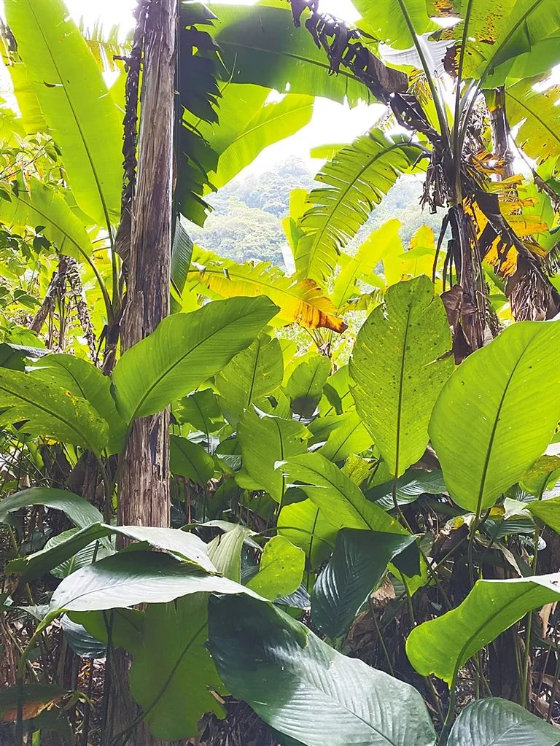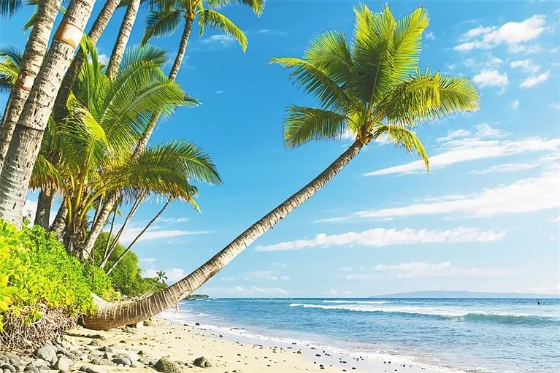By continuing to browser our site and use the services you agree to our use of cookies, Privacy Policy and Terms of Use. You can change your cookie settings through your browser.
An abundance of sunlight and rainfall in Hainan creates good conditions for the growth of all sorts of different types of plants. A veritable treasure house of tropical biodiversity and genetic resources, scientists have identified over 5,800 vascular plants (previously known as “higher plants,” this phylum—which spans everything from edible crops to trees—is defined as “plants which have roots, leaves, and stems”) on the island. These range from needled conifers such as Tenasserim and Dacrydium pines to large-leafed megaphylls such as the giant taro, bananas, and palms. Within the natural world, the gargantuan leaves of this genus not only provide a shady respite from the sun, they also provide habitat for a vast variety of insects.
Giant Taro: Toxic Beauty
As one of the representative plants of Hainan's National Tropical Rainforest Park, the giant taro (Alocasia macrorrhizos) is known for its shiny green leaves up to as much as one by three meters. In urban environments, some people use artificially cultivated alocasia as houseplants.
Despite a sap that causes an itchy rash and the genuine risk that accidental ingestion may lead to heart palpitations (or even cardiac arrest), the roots of this highly toxic plant—whose fanciful Chinese names translate to things like “wolfsbane” and “sharp-toothed taro,”—have shown great promise in recent year for a variety of medical uses.

Giant taro (Alocasia macrorrhizos) in the tropical rainforest. (Photo by Li Tianping / Haikou Daily)
Aplosonyx, a small orangey-red beetle, loves to eat giant taro leaves. In order to avoid the toxins in the sap, this tiny beetle cuts a circle and then munches down.
Although the leaf-cutting aplosonyx's feeding habits damage the giant taro, they have a mutually beneficial relationship, which includes pollination of the plant and, at the same time, food and shelter for both mature insects and their immature offspring.
Banana: A Symbol of Vitality
Bananas, plantains, and other members of the Musa genus have big, flat leaves and delicious fruits.

Wild tangerine and banana in Wuzhishan. (Photo by Chen Geng / Hainan Daily)
There are more than 1,000 species of Musa, including bananas, plantains, and all kinds of wild bananas. One rare wild banana found on Hainan is purple and red when ripe instead of yellow. The leaves of mature plants are usually two to three meters long, and the fleshy fruit is soft and white.

Qi Baishi's "Bajiao Shuwu Tu". (File Image)
China has a long tradition of cultivating bananas. In ancient Chinese literary and artistic works, there are many poems and paintings about bananas as, historically, people felt the fat branches and large leaves symbolized vitality and strength. Qi Baishi (1864 - 1957) is a famous Chinese painter noted for his works' whimsical, often playful style. One of his more famous works, published in more than a dozen books, the Bajiao Shuwu Tu, shows a scholarly study surrounded by lush banana trees. Even though they are lightly outlined, they come alive off the page.
Coconut Palms: Bowing with the Wind
Palms are another megaphyll found on Hainan. The island’s tropical monsoon climate is perfect for growing palms, and 68 species in 32 genera (including coconuts, royal palms, betel nuts, and bangalow palms) have been identified. Because of its excellent characteristics, coconut trees are widely planted in cities and counties throughout Hainan. Regarding cash crops, coconut, and betel (also called areca) are the most commonly cultivated palms. Like giant green feathers, coconut palm leaves can grow to three or four meters. Shading the ground beneath, the giant leaves look the way they do to avoid being damaged by typhoons.

Why do plants grow giant leaves, and what are their benefits? According to experts, megaphyllous plants mostly grow in tropical areas. They like light and heat. The larger leaf area helps them absorb the sunlight necessary for photosynthesis. Additionally, the transpiration required by hot weather ( where plants absorb moisture from the soil to cool down) is improved by these large leaves and helps them make it through the tropical summers.
FTP Expert Talks | Xiaodong Lee, Vice President of the Internet Society of China and Founder of the Fuxi Institution: Hainan is the "Nebula" of New Digital Youth
09:47, 12-September-2025Hainan Issues Offshore RMB Bonds in HK for 4th Consecutive Year
09:46, 12-September-20252025 Hainan FTP International Students Content Creation Project
02:28, 12-September-2025What Makes "Hainan Travel" So Appealing?
09:38, 11-September-2025100 Days to Go: What's Next for Hainan-Hong Kong Cooperation?
09:38, 11-September-2025Expert Talks Ep. 4: The Future of the FTP's Digital Economy
09:35, 11-September-2025By continuing to browser our site and use the services you agree to our use of cookies, Privacy Policy and Terms of Use. You can change your cookie settings through your browser.





